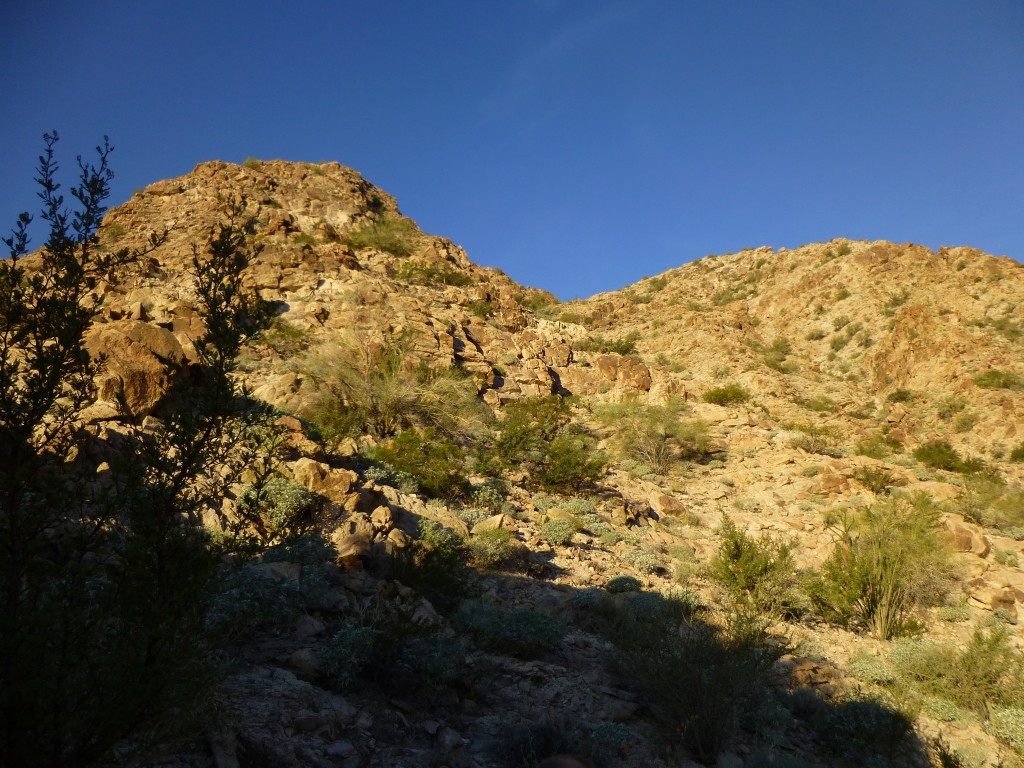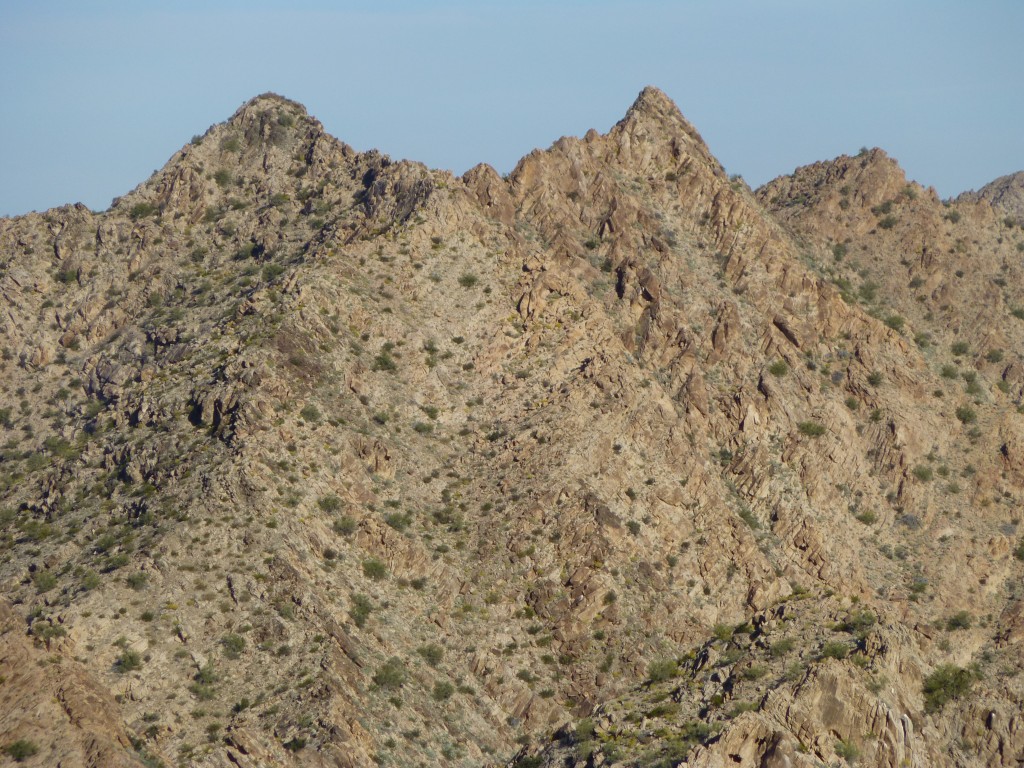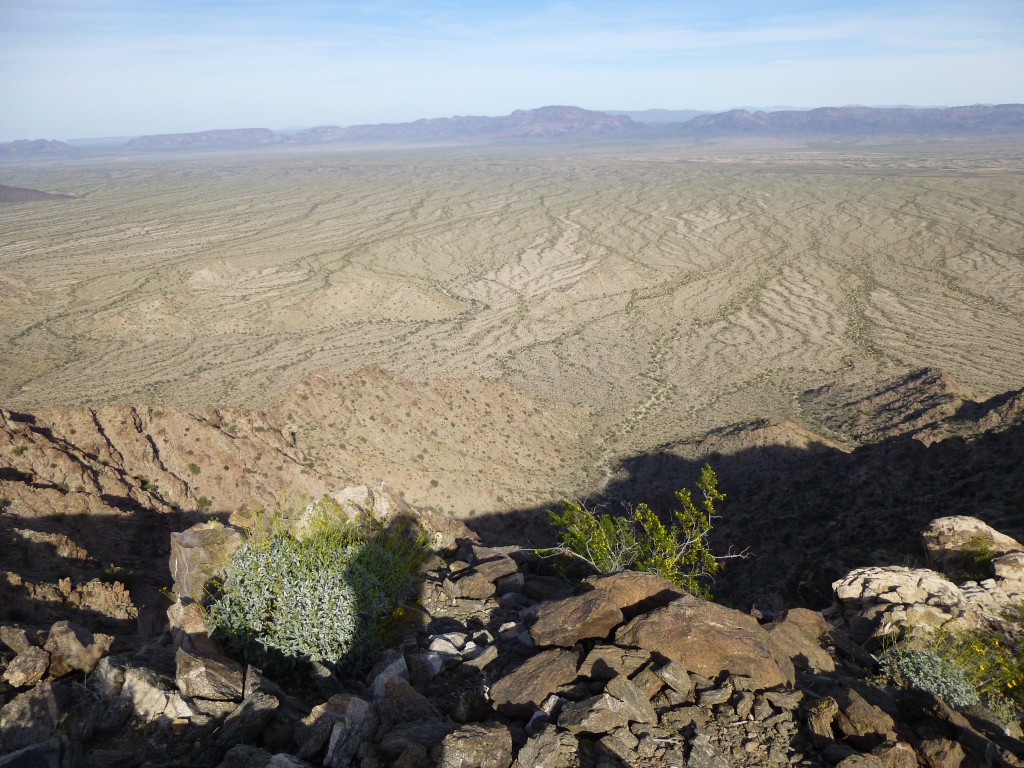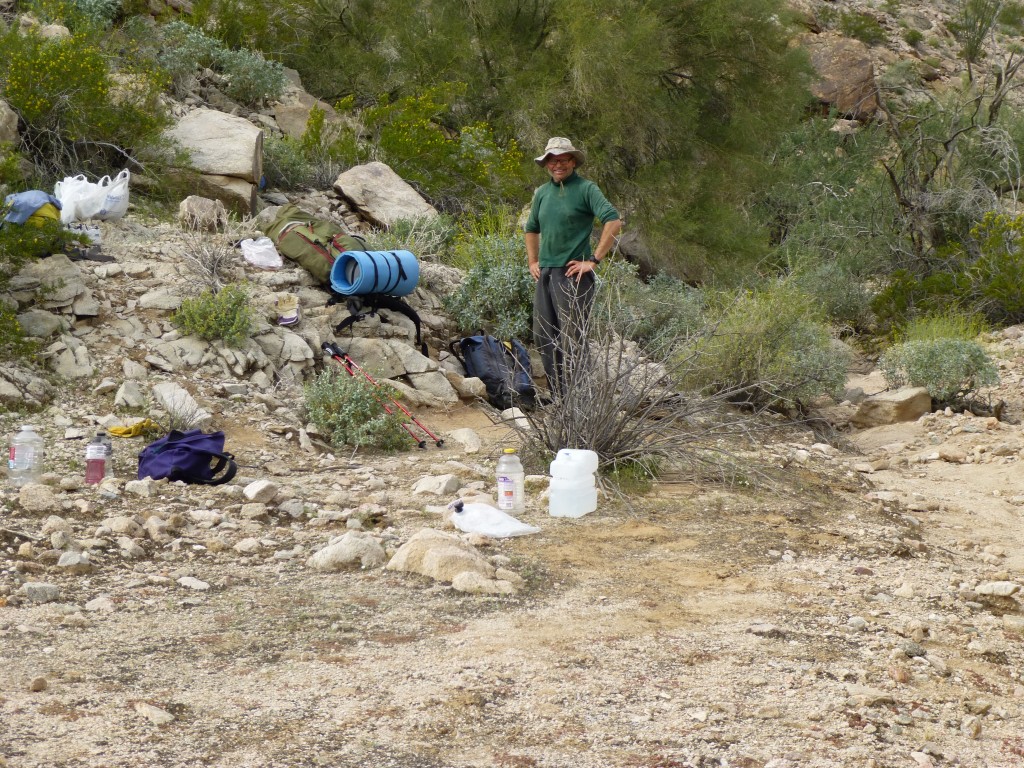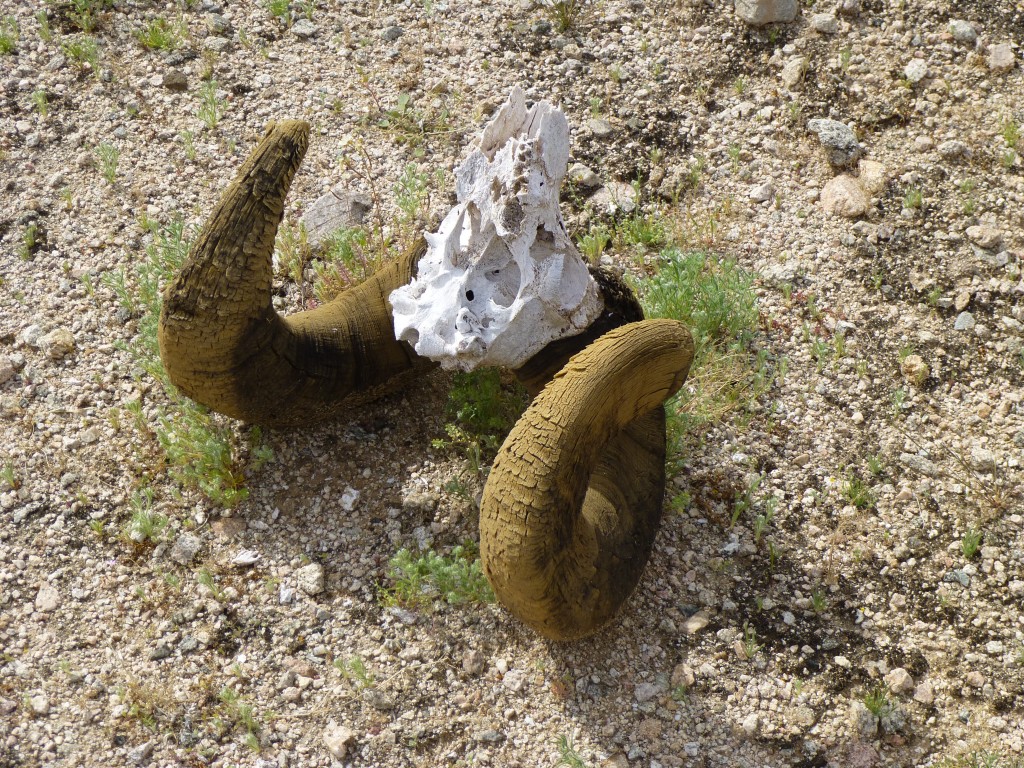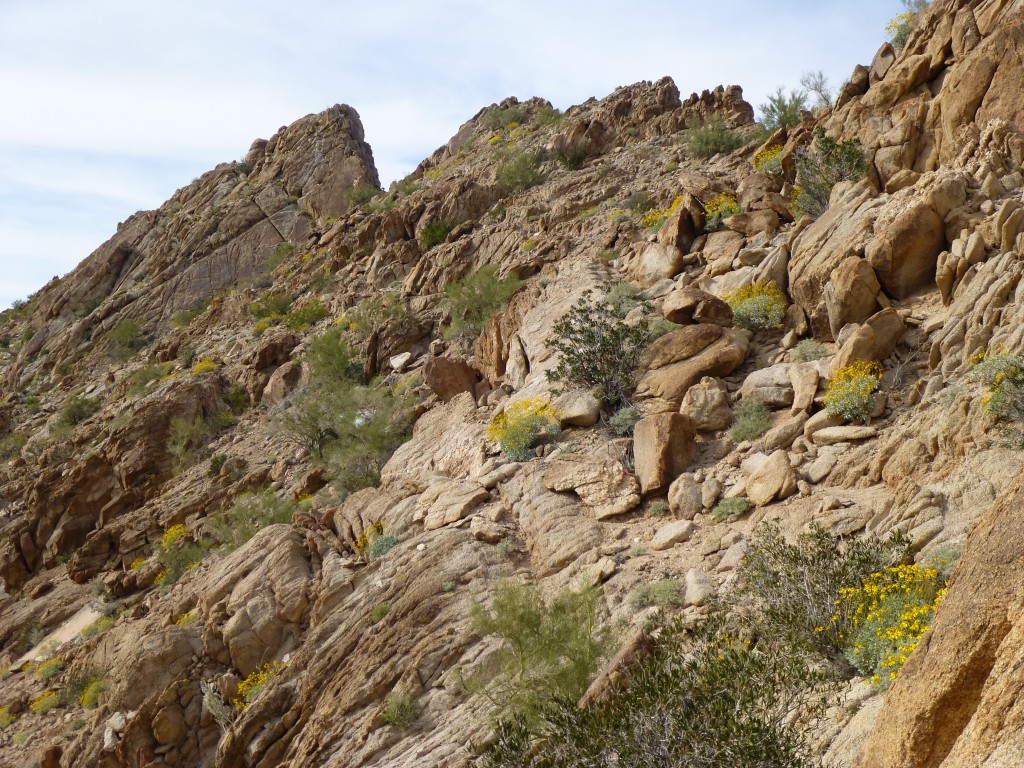Day 4: In a way, we had been dreading this day. Camp One had been our home for days, and it felt like we were just settling in. The only sensible way to move farther north and climb the rest of the peaks was to pack up everything and take it with us. The harsh reality was that there was no water up north, not a drop – we had to carry it all. We filled all our jugs – damn, water is heavy. We needed enough for 5 days and nights, enough for drinking and cooking. Four quarts a day was not quite enough. Experience had shown that five was the minimum – less than that would get you into trouble, even in cool winter weather. It’d be one thing if you were just spending your days lying in the shade, but climbing mountains burns up a huge amount of energy. Also, the air is so dry in this part of the desert, with humidity commonly in the single digits, that your body loses moisture very quickly. Four quarts for drinking, one for cooking.
Mark had a big external frame pack, which lent itself to carrying a large load. Even his day pack was huge, probably almost as big as my backpack. We whittled down our loads as much as we could, only taking the absolute necessities. I had almost sixty pounds of water, most of it in my two packs and even a gallon jug in each hand! Add in things like sleeping bag and air mattress, food for a week, fuel cannisters, cooking pot, first aid kit, clothing, GPS, headlamp, a pair of shoes, etc, etc, etc (literally everything one would need to survive for a week), and my load felt like it was a hundred pounds!! I just didn’t see it coming. Before the trip, I had sworn that I could carry any load, no matter how heavy, for short distances. Well, no amount of ruminating had prepared me for what I felt when that load was on my back. We literally staggered out of Camp One. I weigh 155 pounds, so this was agonizing, even in the cool air of early morning.
We said little as we moved north. The effort was made worse by the endless series of gullies we had to cross. Thankfully, it was only 0.7 mile until we reached the point where we dropped our packs and got ready to start our first climb of the day. Mark had a good idea – find a stopping place with rocks big enough that we could back on to them and then take off our packs, then reverse the process to put them on again. The insane weight of the packs made it almost impossible for Mark to lift up my pack from the ground to help me put it on, and vice versa. God, it felt good to get out from under those packs!
We hid our gear so it wouldn’t be found by anyone (it turned out that we had nothing to worry about, as we never saw another soul for the rest of the trip). Putting on our day packs, we set out for our first climb of the day. This peak, like most all of them throughout the range, was steep and rocky. True to the range name, it was all granite, much of it badly decomposing. Peak 2190 was a 1,200-foot climb, like many in the range, and we were on top in an hour and a half.
This was a really nice peak, and we soaked up the view. Something that impressed us was the view northwest to our next summit. This was a very rugged part of the range, as shown by this next photo.
It was so good not to be carrying those heavy packs, but by 10:30 we were back down and made ready to continue north. The grueling march of a mere 1.5 miles took a full 2 1/4 hours – the weight was killing us. Once again, grateful to be out of the packs, we got ready to climb. This time, our goal was one of the highest peaks in the range. We studied the slopes carefully before starting out, but somehow got off route. Before we knew it, we were bogged down on a wild ridge, steep and rough – the climbing was painfully slow, and finally we had to stop to take a GPS reading. Damn, we had taken a wrong gully! It took some dicey Class 3 and 4 to get us on top of Point 2273, well north of where we wanted to be. Walking the broken ridge south worked out, thankfully, getting us over to the highest part of Peak 2350. Even that was a Class 3 scramble. Here is a view from the top of 2350, looking east across the desert to our starting point days earlier, a low gap in the Growler Mountains just to the right of center.
There, we found something really bizarre. Back in 1962, the Army Corps of Engineers had left a benchmark, plainly labeled “Cristobal”. This was weird, because there actually is a Cristobal Benchmark in the range, but it sits over a mile to the north. Dueling Cristobals – curiouser and curiouser. This was an awesome place, and how we wanted to stay and soak it all in, but we had to go. We needed to find a much easier way down, and that we did. It was 5:30 PM by the time we got back to our gear, and we were wasted. Getting all of our climbing done depended on keeping to a schedule, or we would run out of water out in some desperate place. It seemed like the odds were against us for reaching our next camp that day.
Into our packs we climbed and set off north once again into the failing light. Our goal was to reach the spot where Mark had left his cache of water back on Day 2. Words fail me when I try to describe the misery of continuing with those packs. By some herculean effort, we made another 2.3 miles, much of it in the dark, before collapsing from shear exhaustion. The GPS showed we were a mere 500 feet from Mark’s cache, but we couldn’t carry those packs another step. Numb from the effort, we rested for a bit, then Mark headed off to retrieve the water and other supplies he had cached days before. Once he was back, we set up Camp Two. It felt good to prepare a hot meal.
Climbing peaks like this consumes a huge number of calories, but we hardly ate any food all day long. The heat and exhaustion sapped our appetites. It was only at night that we made the effort to cook and eat. Our feet were sore, and I had already worn a patch raw on my lower back from my overloaded pack. We crawled into our sleeping bags right after eating. What a helluva day, starting in the dark and finishing well after dark. It was important to keep reminding ourselves that we were out here to climb, that that was the goal and we couldn’t lose sight of it. We had climbed two nice big peaks today, though, and that made all the effort worthwhile.
Day 5: The next morning, we packed up early and got ready to move again. Here is a picture of Camp Two.
We passed east of a few small bumps, then came to the head of a nice flat valley. Dropping our loads again, we donned day packs and set out to do a couple of small peaks, a pleasant change from all of the big ones we’d be doing. By 8:20 AM, we stood on top of Peak 1475. A layer of high, thin clouds helped us feel cooler.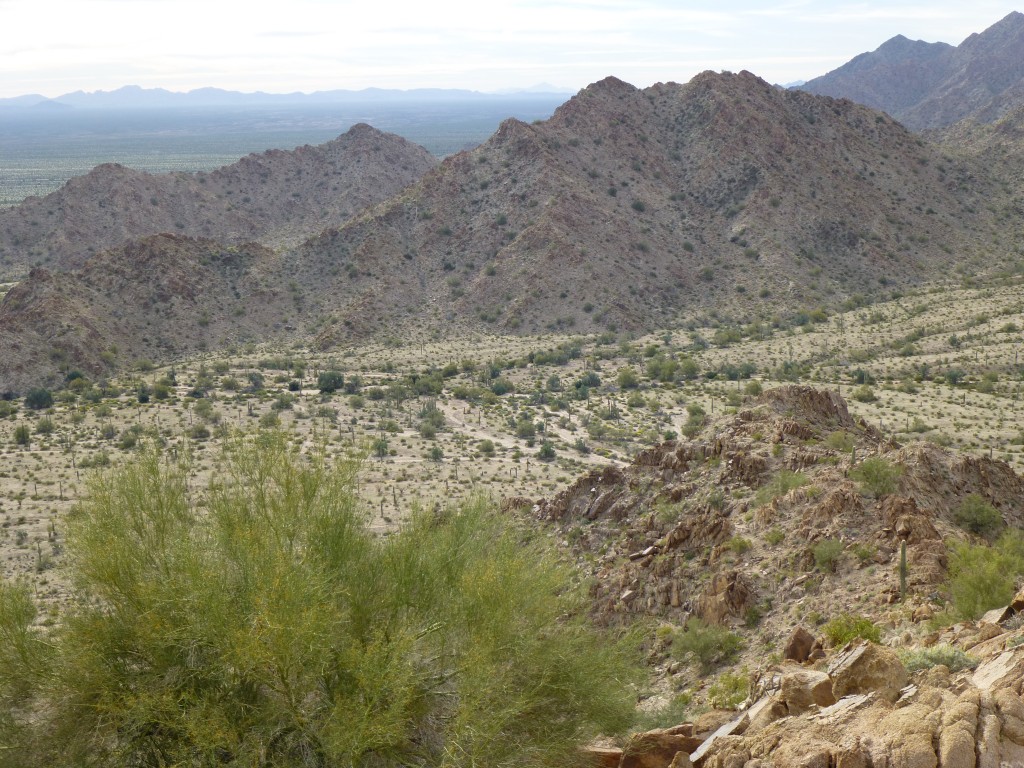
By a different route, we dropped back down to the valley bottom, then walked north a short distance to the base of our next one. Straight up the easy south ridge and there we were, on top of Peak 1430. There’s nothing quite like the feeling of walking on to the summit of a peak nobody has visited before and then leaving your mark. After a brief stay, we made our way back down and over to our gear. It was all right where we had left it. Although we had some concern about animals or people messing with our gear, especially our water, they were unfounded.
It was 10:30 AM by the time we were loaded up and started off again. The trek was arduous, painful and slow. Straight north we went across the open desert. It would have been easier were it not for the countless gullies, large and small, that we had to cross en route. The direction of the drainage lay at a 90-degree angle to our path of travel, so we called it “crossing the grain”. How we grew to hate the grain, and soundly cursed it as we traveled. Hours passed, and it was after 1:00 PM by the time we dropped our loads once again.
From a little bump labeled 989 on the map, we started west. It was strange that we had seen desert bighorn sheep poop everywhere on these high peaks, but never a live one. They had no doubt seen and heard us coming and beat a hasty retreat. The one old ram we did see wasn’t under circumstances we would have wished.
Our next peak was a few miles’ walk west up a valley. We had been eyeballing it for a few days from other mountains we had climbed, and thought we had picked out the highest part of it. The thousand feet of climbing up its eastern slope to the summit ridge went well, and put us in a good position to finish it off. Here is the great view that met us on the ridge.
This peak was a series of jagged teeth, steep on its west side as you can see in the above photo, and every bit as steep on the east. It was an enjoyable scramble to traverse across, with some Class 3. Naturally, the highest point was the farthest west, the one you see on the left. Peak 2090 was probably the most enjoyable of the trip so far. It really held our attention as we climbed it. It would have been great to have hung out on the summit for a while, but it was already after 3:30 by the time we got there. It seemed like we never could relax on a summit, that we were always in a hurry. Such is the way of the peakbagger, more often than not.
We carefully made our way down off the summit and then down the thousand feet of the eastern slope. That done, then the trek back to our packs – holy crap, it was already 5:30 PM. All afternoon, we had been dreading putting on those huge packs again. Perhaps Mark more than I, because he had today added that 30 pounds of water to his load. He was really feeling it. As darkness fell, we found ourselves struggling through a series of gullies that lay across our path, each one more difficult than the last.
All we wanted was to find a spot to camp, a spot that had a few rocks big enough to help us take off our packs. It grew dark, we turned on the headlamps, and forged ahead. Soaked in sweat, we cursed each successive obstacle in our path. Finally, at our wit’s end, we decided to take the next thing that came along, focusing mainly on finding some big rocks. Well, we found our spot alright – cramped, sloping, rough – without a doubt the worst of the trip. Camp Three really sucked! All that desert, and we ended up in this desperate spot. Exhausted, we were in no position to look for any better. Half-heartedly, we cooked some food and tried to re-hydrate. Mark spent a miserable night, the rocks prodding him through his foam mattress. My snoring didn’t help either. It had been a disappointing end to our day. Our goal had been to make this camp some distance farther on, so now we were behind schedule. It’s not that we couldn’t have added more days to the trip – the simple fact was that we’d eventually run out of water.
Stay tuned for the next part of the story: Granite Mountains Expedition – Part 3
Please visit our Facebook page at: https://www.facebook.com/pages/Desert-Mountaineer/192730747542690

